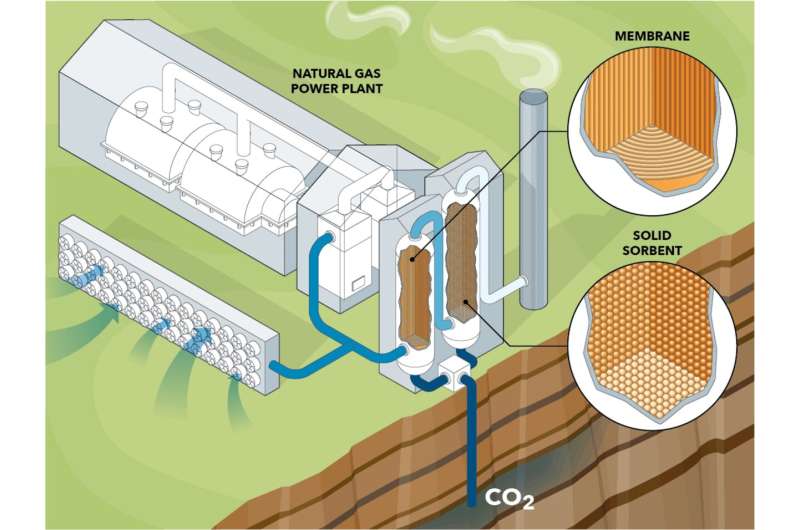Turning the problem into the solution in natural gas power plants

Natural gas is one of the largest contributors to the world’s energy and a viable fuel for many different uses. Natural gas combined cycle (NGCC) plants, in particular, are a highly efficient system design that will likely continue providing long-term baseload electricity.
However, there’s a problem. Natural gas is a fossil fuel, and the increased use of fossil fuels releases more carbon dioxide (CO2) in the atmosphere—a primary concern for climate change.
“As more industries move toward net zero emissions, carbon capture and storage with high capture rates will be necessary to keep natural gas around in a low-carbon future,” said Katherine Hornbostel, assistant professor of mechanical engineering and materials science at the University of Pittsburgh Swanson School of Engineering. “And as intermittent renewable energy expands, natural gas power plants will have to operate at low-load conditions more frequently.”
Hornbostel, who is well-versed in carbon capture technology, led a team of researchers from West Virginia University, University of Toledo, and AristoSys LLC on an ARPA-E project to model a novel hybrid carbon capture design at NCGG plants that nearly reached net-zero emissions.
They modeled a hybrid carbon capture system that attaches to an NGCC power plant and consists of a membrane and solid sorbent systems. For the solid sorbent system, the team modeled fixed bed absorbers packed with metal-organic framework (MOF) solid sorbents that absorb CO2 and undergo temperature swing desorption using steam from the power plant.
Hornbostel’s research group focused on optimizing the design of this solid sorbent system and found that the optimal conditions were reasonable and compatible with integration into an NGCC plant. They believe that future work with a solid sorbent that’s more suited for direct air capture could enable net-zero or net-negative CO2 emissions.
Although Dr. Hornbostel’s research group focused on the solid sorbent system design, the entire project team worked together to model and optimize the complex integrated NGCC + membrane + solid sorbent system. The team developed an integrated system where a membrane carbon capture system first processes natural gas exhaust and then a solid sorbent carbon system.
Their model indicated a 99.3 percent carbon capture rate from the inlet natural gas stream at high-load conditions and a 99.6 percent carbon capture rate at low-load conditions. They also found that their hybrid system would be more cost-competitive than a benchmark MEA solvent carbon capture system that performs 90 percent capture in futures with high CO2 taxes.
Although their results didn’t quite reach 100 percent carbon capture (net-zero emissions), Hornbostel is confident that net-zero and perhaps even net-negative emissions are attainable with their design by optimizing the solid sorbent material selected.
“Though we weren’t able to achieve net zero emissions, we came encouragingly close,” Hornbostel said. “This was the step we needed to take to demonstrate that natural gas can be part of the electricity mix in a decarbonized future.”
The papers, “Flexible carbon capture using MOF fixed bed absorbers at an NGCC plant” and “Optimization of a Natural Gas Power Plant with Membrane and Solid Sorbent Capture Systems” were recently published in Carbon Capture Science & Technology.
More information:
Mahpara Habib et al, Flexible carbon capture using MOF fixed bed adsorbers at an NGCC plant, Carbon Capture Science & Technology (2023). DOI: 10.1016/j.ccst.2023.100170
Frits Byron Soepyan et al, Optimization of a Natural Gas Power Plant with Membrane and Solid Sorbent Carbon Capture Systems, Carbon Capture Science & Technology (2023). DOI: 10.1016/j.ccst.2023.100165
Citation:
Turning the problem into the solution in natural gas power plants (2023, December 11)
retrieved 12 December 2023
from https://techxplore.com/news/2023-12-problem-solution-natural-gas-power.html
This document is subject to copyright. Apart from any fair dealing for the purpose of private study or research, no
part may be reproduced without the written permission. The content is provided for information purposes only.
For all the latest Technology News Click Here
For the latest news and updates, follow us on Google News.

